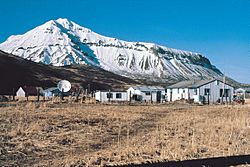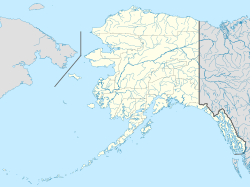False Pass, Alaska facts for kids
Quick facts for kids
False Pass
Isanax̂
|
|
|---|---|

False Pass looking north
|
|
| Nickname(s): | |
| Country | United States |
| State | Alaska |
| Borough | Aleutians East |
| Incorporated | October 19, 1990 |
| Area | |
| • Total | 65.55 sq mi (169.76 km2) |
| • Land | 25.07 sq mi (64.93 km2) |
| • Water | 40.48 sq mi (104.83 km2) |
| Elevation | 30 ft (9 m) |
| Population
(2020)approximately 35 permanent residents
|
|
| • Total | 397 |
| • Density | 15.84/sq mi (6.11/km2) |
| Time zone | UTC-9 (Alaska (AKST)) |
| • Summer (DST) | UTC-8 (AKDT) |
| ZIP codes |
99583
|
| Area code | 907 |
| FIPS code | 02-24660 |
| GNIS feature ID | 1418574 |
| Website | City Website |
False Pass (Aleut: Isanax̂) is a city on Unimak Island, in the Aleutians East Borough of southwestern Alaska, United States. Although the population was marked 397 including seasonal fish processing plant workers at the 2020 census, approximately 35 residents call it home year-round.
History
False Pass is an early English name for Isanotski Strait on which the city of False Pass is located. The strait was called "False Pass" by early American sailing ship captains because it was thought to be impassable for their deep draft vessels at the northern end. A salmon cannery was built on the Unimak Island side of the strait in 1919 which provided the nucleus for the modern settlement. A U.S. post office with the name of False Pass was established in 1921 which gave official status to the community.
Commercial fishing for salmon, cod, halibut and crab continues to be the core of the community's lifestyle and economy.
Geography
False Pass is at 54°49′40″N 163°23′57″W / 54.82778°N 163.39917°W (54.827886, -163.399090). It is near the eastern end of Unimak Island, in the Aleutian Islands chain. Part of the city (26.093 km2, or 10.075 sq mi) is on the mainland's westernmost tip Alaska Peninsula, across the Isanotski Strait (about 600 meters at the closest point), although that section is nearly unpopulated. The city boundaries include the abandoned villages of Morzhovoi and Ikatan.
According to the U.S. Census Bureau, the city has a total area of 68.3 square miles (177 km2), of which 26.9 square miles (70 km2) is land and 41.4 square miles (107 km2) (60.63%) is water.
Transportation
Boats and aircraft are the only transportation to and from False Pass. Aircraft use False Pass Airport.
Demographics
| Historical population | |||
|---|---|---|---|
| Census | Pop. | %± | |
| 1930 | 59 | — | |
| 1940 | 88 | 49.2% | |
| 1950 | 42 | −52.3% | |
| 1960 | 41 | −2.4% | |
| 1970 | 62 | 51.2% | |
| 1980 | 70 | 12.9% | |
| 1990 | 68 | −2.9% | |
| 2000 | 64 | −5.9% | |
| 2010 | 35 | −45.3% | |
| 2020 | 397 | 1,034.3% | |
| U.S. Decennial Census | |||
False Pass first appeared on the 1930 U.S. Census as the unincorporated area of "Unimak." This included the populations of both False Pass and Ikatan. It reported again in 1940, but in 1950, was returned separately as False Pass (as an unincorporated village). It was made a census-designated place in 1980.
Education
Aleutians East Borough School District (AEBSD) operates the False Pass School.
c. 1978 the school, then a part of the Aleutian Region School District, had a single teacher, and 8 students.
Picture gallery
See also
 In Spanish: False Pass para niños
In Spanish: False Pass para niños





















